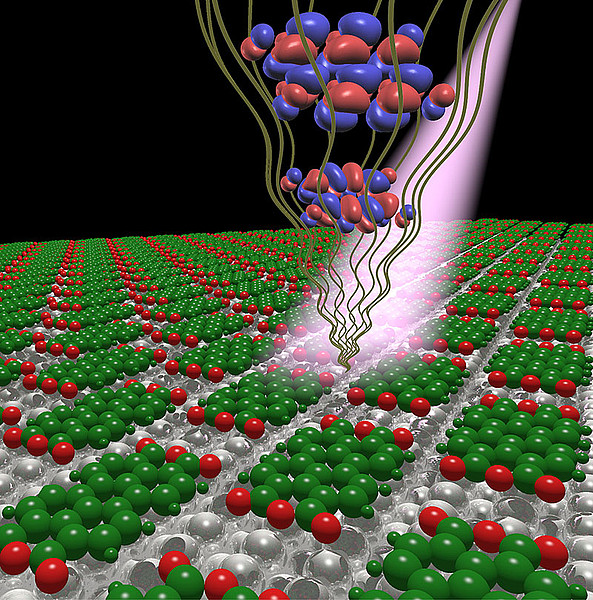

Photonen schießen Elektronen aus einer Schicht von Molekülen auf einer Silberoberfläche, was die Rekonstruktion von Molekühlorbitalen ermöglich. Foto: Lüftner/Institut für Physik der Uni Graz
In quantum physics, electrons behave both as particles and as waves. The wave nature can be described by the spatial wave function, the orbital. “Orbitals contain information on the spatial distribution of the electrons at a certain energy. If they are known, all the relevant properties of a material can be derived,” explains Prof. Peter Puschnig from the University of Graz.
However, the laws of quantum mechanics prevent the direct observation of how an electron propagates as a wave. Two years ago, however, scientists from Graz and Jülich for the first time recorded orbitals of larger complex molecules. For their measurements, they used photoelectron spectroscopy, based on the photoelectric effect.
In this procedure, a molecular layer on a silver surface is bombarded with photons (particles of light), causing the energetically excited electrons to be released. “The electrons do not simply fly around in space. Instead, their angular and energy distributions enable us to draw conclusions about the molecular orbitals,” says Puschnig.
By further refining this method, the scientists have now succeeded in reconstructing the orbitals in all three dimensions. This meant that the experiment had to be performed with various photon energies, i.e. different wavelengths of light, in the ultraviolet range. “Additional information on the third dimension can be obtained with variable wavelengths in much the same way as a camera takes repeated pictures of one object with a variable focus,” explains Prof. Stefan Tautz from Forschungszentrum Jülich.
However, it took a long time before it was possible to combine the data gathered in different measurement series into one spatial model. “Until now, we were unable to compare the measured intensities originating from different photon energies,” says Prof. Michael Ramsey from the Department of Physics at the University of Graz. In order to obtain comparable values, the Jülich researchers installed their detector at the Metrology Light Source (MLS) of the Physikalisch-Technische Bundesanstalt (PTB) in Berlin.
“Our synchrotron radiation source is one of the few worldwide that provides a precisely calibrated photon flux,” explains Dr. Alexander Gottwald from PTB. On the basis of the data from the calibrated measurements, the scientists at Graz were then able to reconstruct the electron distributions in three dimensions within the context of the research core are “Models and Simulation”.
The research team from Jülich, Graz, and Berlin was thus able observe the wave function, which according to the rules of quantum mechanics is in fact considered unobservable. The results are long-sought proof of the orbital concept as such. The result is also relevant for physics: “Our experiment provides important new physical insights into the underlying photoelectric effect,” says Stefan Tautz. Somewhat surprisingly, the electrons that are released can be described in a manner very similar to free electrons – an idea that was rejected almost 50 years ago on the basis of the assumed scattering by the atomic cores.
Original publication:
S. Weiß, D. Lüftner, T. Ules, E. M. Reinisch, H. Kaser, A. Gottwald, M. Richter, S. Soubatch, G. Koller, M. G. Ramsey, F. S. Tautz, and P. Puschnig, Exploring three-dimensional orbital imaging with energy dependent photoemission tomography, Nature Communications (2015)
Picture material on request.
Contact:
Assoz.-Prof. Dr. Peter Puschnig
Institute of Physics, University of Graz
Tel.: +43 316 380-5230
E-Mail: peter.puschnig@uni-graz.at












